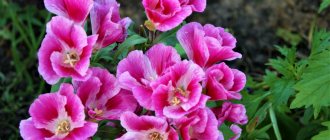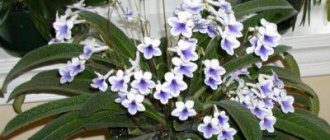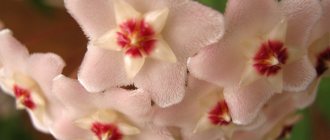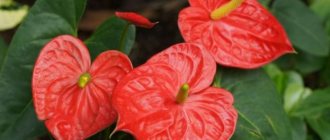floravdome.ru > Cacti and succulents > Pedilanthus flower care, photo
Pedilanthus involuntarily attracts the eye in any room. A bright, cheerful plant is rapidly gaining popularity among gardeners. In addition to its undeniable advantage - its spectacular appearance, pedilanthus is also a useful plant, having a healthy effect on the air in the room, and the essential oils contained in the leaves have a beneficial effect on human well-being. A bonus to all these advantages is the ease of caring for the flower, which allows it to grow well even with inexperienced gardeners.
Indoor flower pedilanthus (Pedilanthus) is an unpretentious evergreen plant of the Euphorbiaceae family.
Its homeland is the American tropics, where it grows in low bushes.
The bright green succulent stem can bend arbitrarily, the dense leaves of an ovoid-pointed shape shine from the wax covering them. Pedilanthus also has variegated (variegated) species.
At the end of autumn, pedilanthus can bloom with small bright pink or red flowers, collected in inflorescences. Flowering occurs in November - early December under conditions that best match natural ones. At home this happens quite rarely.
Pedilanthus variegata
Pedilanthus is a succulent plant. The flower is unpretentious and easily tolerates temporary difficulties, rearrangements, shaping and pruning.
But, in order to get a beautiful, healthy plant, you must, of course, provide the flower with suitable conditions and provide the necessary care.
Accommodation
Pedilanthus is very light-loving. Variegated species especially need light.
The best place for a flower is a windowsill on the southwest, southeast or south side. In summer, at noon, the plant is shaded from direct sunlight, but the morning and evening sun only benefits pedilanthus.
! In bright sunlight, pedilanthus leaves may take on a delicate pinkish tint.
In dark rooms and on northern or shaded windows, pedilanthus also grows, but loses all its decorative effect - the distance between the leaves increases, the branches stretch out and lose their elasticity. If it is not possible to rearrange the plant, then mandatory lighting is required.
Pedilanthus needs fresh air, but it must be protected from drafts and sudden changes in temperature. When overcooled, the plant quickly sheds its leaves and needs a long recovery.
Pedilanthus titimoloides. Leaves turn pink in the sun
Types and varieties of hemanthus with photos and names
Of all the types of hemanthus, the most popular among gardeners are: scarlet and white-flowered. However, scadoxus are also often called hemanthus; these plants are very similar to each other and are related. Since scadoxuses are also part of the Amaryllidaceae family and are grown indoors in almost the same way as hemanthuses, a description of some species of this plant will be given below.
White-flowered haemanthus (Haemanthus albiflos)
This evergreen plant is highly decorative. Its smooth, thick, wide, tongue-shaped leaf plates are dark green, they reach up to 10 centimeters in width and about 20 centimeters in length, with cilia along the edge. Powerful peduncles have a height of about 25 centimeters. At the tops of the flower arrows, spherical umbrella-shaped inflorescences of white color are formed, which are decorated with golden-colored anther tips.
Of all the varieties of this species, the most popular is Prince Albert: compared to the base species, this variety has larger inflorescences, and they have a bright orange color.
Scarlet haemanthus (Haemanthus coccineus)
The leaf blades with red tops reach a height of about 50 cm. The peduncles of the species are spotted, red spectacular inflorescences are decorated with yellow anthers. The perianth petals are quite large. When grown indoors, such a plant does not bloom every year, but inflorescences form in the autumn and fade relatively quickly.
Haemanthus lindenii
The bush has long-petioled leaf plates arranged in 2 rows, with longitudinal folds running along the midrib. The height of the peduncles is about half a meter, and the inflorescences reach about 20 centimeters in diameter. They consist of umbrellas of deep red color, reaching up to 50 mm in diameter.
Snow white haemanthus (Haemanthus candidus)
This variety is similar to the white-flowered hemanthus, however, it has pubescence on the peduncles and the underside of the leaf blades.
Tiger Haemanthus (Haemanthus tigrinus)
This plant was created through selection. The length of the leaf plates is about 0.45 m; there are brown spots on their surface. The height of the peduncles is only about 15 centimeters; large red inflorescences form on their tops.
Haemanthus puniceus
Or Scadoxus puniceus. The foliage of this plant is leathery with a wavy edge. Red inflorescences reach up to 10 centimeters in diameter.
Haemanthus multiflorus
Or Scadoxus multiflorus. The leaf blades of this species are veined. Large inflorescences of a scarlet-red or pale pink hue are formed on long peduncles.
Haemanthus Katherinae
Or Scadoxus Katherinae. This variety is very popular among gardeners. The height of the false stem is about 15 centimeters; thin and long leaf plates sit on it. In the last weeks of summer, red inflorescences form on the flower.
Hemanthus (DEER TONGUE). HOUSE BULB PLANTS
Watch this video on YouTube
Air humidity
Pedilanthus tolerates normal indoor humidity levels well, but periodic spraying, especially in the morning on hot summer days or during the heating season, has a beneficial effect on it and contributes to both general health and accelerated growth.
Also, for hygienic purposes, once a month the pedilanthus is given a warm shower, which washes away the dust and stimulates the plant. After a shower, it is recommended to leave the flower in the bathroom until the leaves dry completely.
Pedilanthus watering
Water the pedilanthus as needed, without drying out or over-wetting the bud. A signal for watering can be the drying of the top layer of soil by 1-1.5 cm.
Use soft water, standing for at least a day, at room temperature or slightly higher.
On summer days, when the soil dries out quickly, regular watering is required.
In winter, if the plant is kept at the required low temperature, watering is reduced to once a week, but care must be taken to ensure that the soil does not dry out completely.
! If overdried for a long time, pedilanthus can shed its leaves; if it is over-watered, its roots can rot, and it also reacts by shedding its leaves. Therefore, to maintain the healthy appearance of the flower, it is important to maintain a balance of watering.
Pedilanthus dormant period
From late September to mid-February, pedilanthus begins a period of rest. At this time, lower the temperature to +15o - 17o. Watering is reduced to once a week, and fertilizing is stopped completely. The soil should not be allowed to dry out completely.
It is recommended to periodically spray the plant, and if the room has dry air from heating appliances, then take a warm shower once a month to maintain the humidity level and eliminate dust. The flower is placed in a “wintering” place (loggia or window sill) with a low temperature only after the leaves have completely dried.
Pedilanthus must be protected from drafts or temperature changes. When ventilating, cover the plant if cold air can get into it.
As with many succulents, dormancy for pedilanthus is an important part of proper development. At this time, the plant’s vital processes slow down and accumulate strength for the next growing season.
In addition, it is during the dormant period that flower buds are formed, therefore, if you want to achieve flowering from the pedilanthus, provide it with maximum not only active summer growth, but also the rest it needs in winter.
If the pedilanthus blooms in the fall, then a period of rest is provided for the plant after flowering ends.
Flowering pedilanthus in nature
Species found in indoor floriculture
The following species have most successfully adapted to the conditions of modern apartments, which are strikingly different from the microclimate of the plant’s natural habitat:
- Pedilanthus tithymaloides. Most common in indoor floriculture. Even among his “relatives” he stands out for his unpretentiousness. Height - about 70 cm. Leaf length - 9-10 cm, width - 4-5 cm. The color of the leaf blade gradually changes from dark green in the middle to pale light green or cream along the edges. If the leaves are regularly exposed to the sun, the light areas take on a pinkish tint. Leaf color depends on growing conditions. The inflorescences are crimson. The stem has a very unusual zigzag shape, changing direction of growth with the appearance of each subsequent leaf. Because of this configuration, Pedilanthus titimaloides has earned the nicknames “devil’s backbone”, “devil’s bridge”, “Jacob’s ladder”. There is a breeding hybrid smalii, in which this feature is even more pronounced. Flowering begins towards the end of autumn. During this period, proper watering is extremely important, otherwise Pedilanthus titimaloid will shed not only its leaves, but also its developing inflorescences.
- Pedilanthus coalcomanensis. A graceful low tree. An endemic species that grows in nature exclusively on one of the mountain ranges remote from civilization in western Mexico. Weather conditions change dramatically throughout the year, so the plant sheds its leaves for the winter. The diameter of the inflorescences is up to 4 cm. The flowers are peach or salmon in color with a light pinkish tint.
- Pedilanthus macrocarpus. Succulent in the form of an intensively branching bush. Grows up to 1.5 m in height. Leaves are practically absent, representing scales tightly adjacent to the stem. Stems on the same plant can be either cylindrical or flat. The flowers are usually bright scarlet or coral. On the bracts, the red color smoothly turns into light green closer to the stem.
- Pedilanthus calcaratus. A tree-like plant, widely used in landscape design where the climate allows. Reaches 3 m in height. If it is not warm enough in winter, it partially sheds its leaves. The stems are dark green, almost black. The leaves are small, about 5 cm long, corrugated along the edges.
- Pedilanthus finkii. In nature, it grows under a “tent” of intertwined crowns of taller trees. A low spreading shrub, especially demanding on soil quality. Rapid growth and proper development are possible only in light soil, in which water does not retain and air does not stagnate. The leaves are bright, emerald green, the stems have a glossy shine, the lower part is bare. The stems are straight, smooth, and stand almost vertically, which is why Finca pedilanthus is also known as “Christmas candles.”
Photo gallery: Flower varieties
Pedilanthus titimaloides is the most common representative of the species
Due to the lack of leaves, pedilanthus large-fruited looks very unusual and exotic
Pedilanthus Finca is more demanding on soil quality than its “relatives”
Pedilanthus coalcomanensis is extremely rare in nature, and “in captivity” is also rare
Pedilanthus spur can reach up to three meters in height
Forming and trimming pedilanthus
To grow a thick, lush bush, several plants are planted in one pot.
pruning is carried out at the beginning of the growing season in the spring - overgrown and weakened branches of the pedilanthus are trimmed, and the main ones are pinched at the desired height.
To maintain the shape of the bush, pinch out excessively growing branches throughout the growing season.
Old overgrown bushes can be revived by pruning all branches at a height of 5-8 cm in early spring. After pruning, the lateral buds emerge and the bush is overgrown with new branches. Fertilizing with complex fertilizer will accelerate the growth of greenery.
! Pruning pedilanthus is done only with gloves! The milky juice protruding at the cut sites is dried, and then the cuts are sprinkled with charcoal powder.
Pedilanthus Reproduction
The easiest way to propagate pedilanthus at home is by cuttings.
Pedilanthus cuttings can be taken throughout the growing season, as well as after annual pruning at the beginning of the season.
For rooting, take healthy, strong cuttings of 7-10 cm, remove excess leaves, leaving no more than five. The cuttings are washed to remove milky juice and dried for at least a day.
Root in water, damp perlite or damp sand. The greenhouse will speed up the emergence of roots.
Usually roots appear within 7 to 10 days.
After the roots appear, the cuttings are rooted and cared for like adult plants.
Pedilanthus is also propagated by seeds.
Pedilanthus cuttings prepared for rooting
Description
Pedilanthus is an ornamental, flowering shrub belonging to the Euphorbiaceae family.
Its name comes from Greece from the words shoe ("pedilon") and flower "anthos".
The leaves are light green (dark or light), wavy. They can be sessile or short-petioled, alternate, up to 8-10 cm long, smooth or slightly pubescent.
The stem is cylindrical, grayish or green in color.
The flowers are formed in dense apical inflorescences with two red, small, pointed bracts , about 2 cm in diameter. Inflorescences are pink or red. They resemble the heads of small birds or shoes.
Pedilanthus transplant
Pedilanthus does not need annual replanting. Young plants can be replanted every two to three years, after filling the entire volume of the pot with roots. A signal for this is the appearance of roots in the drainage holes of the pot.
It is advisable to replant at the beginning of the growing season.
The pot for transplanting pedilanthus is larger than the previous one by 2-3 cm in diameter with large drainage holes. A quarter of the pot is drained at the bottom.
The soil must be water- and breathable, loose. The soil is good for succulents. You can use universal soil, but be sure to add coarse sand, coconut shavings or perlite to loosen it.
You can make your own soil by mixing leaf soil, coarse river sand and turf in proportions 2:2:1.
To prevent soil acidification and the proliferation of putrefactive bacteria, finely ground charcoal is added to any soil mixture.
Pedilanthus titimaloidum is the most popular type of pedilanthus in indoor floriculture.
A haircut
Pedilanthus titimaloides can easily be artificially created to form the entire plant or crown. To do this you need to trim it.
To stop the flow of juice, the cuts are sprinkled with sulfur or activated carbon tablets. Keep your pruners or scissors perfectly sharp to avoid lacerations.
Pedilanthus pests
A healthy plant is rarely attacked by pests, and regular inspection of the plant does not leave them any chance to reproduce.
A good way to prevent pests is to regularly spray the flower.
If insects are found, visible individuals are removed manually, then the plant is given a warm shower, trying to wash the foliage as much as possible. After the leaves have completely dried, the plant is treated - with a small number of insects - with green soap, infusion of tobacco or garlic, diluted with alcohol.
If there are a lot of insects and their damage to the plant is already clearly visible, then use insecticides (Aktara, Aktellik, Fitoverm) in accordance with the instructions. Treatment is carried out at least twice with an interval of 7-10 days. The place where the plant stood is thoroughly washed with detergents. It is also recommended to inspect nearby flowers.
Pedilanthus diseases
Most often, pedilanthus diseases are associated with flooding and acidification of the soil, especially in winter, when kept cool.
In this case, rotting of the roots occurs. The signal for this is the lethargy of the branches and the condition of the leaves - they begin to turn yellow, lose their elasticity and fall off.
If root rot is suspected, the plant is immediately removed from the pot, the roots are washed, and all damaged parts are removed. The remaining root system is rinsed in a weak solution of potassium permanganate, the cut areas are sprinkled with crushed coal, and treated with a fungicide, for example, Fitosporin.
The old soil is thrown away, the pot is thoroughly washed with laundry soap. The plant is planted in new soil and given time to adapt. After three to five days, they are cared for as usual, but fertilizing begins only after the plant begins to grow and new young leaves appear.
Problems when growing pedilanthus
- the stems are limp, the leaves grow rarely - the plant does not have enough light
- leaves turn yellow, dry out and fall off in the summer - excessive lighting, low air humidity
- pedilanthus leaves falling off - insufficient watering
- withered leaves in winter (and fall off) – low temperature + lack of light
- pedilanthus abruptly sheds its leaves - a sharp change in temperature, the plant is “frozen.” If the stems are green, then the flower will quickly recover; if some of them turn yellow, then they must be removed. To restore pedilanthus, it requires the most comfortable conditions and carefully selected watering.
As with most euphorbias, pedilanthus should only be handled with gloves. With any damage to the stems and leaves, the plant secretes a poisonous milky sap , which can cause irritation on the skin, and if it gets on the mucous membranes, allergic reactions and poisoning.
The flower should be placed in the house so that children and pets cannot reach it.
At the same time, if the growing pedilanthus is not disturbed, it can be beneficial by clearing the air of toxins and harmful microbes. By releasing essential oils, pedilanthus can increase performance and level of creative energy .
Based on this, pedilanthus is an ideal plant for offices.
Pedilanthus is a flower that brings change. Moreover, the most positive ones.
The appearance of pedilanthus in the house means rearrangement, acquisition of a new piece of furniture or interior.
If you place pedilanthus on your desk , expect a promotion or bonus.
Layings taken from plants in public places or from the street are considered especially valuable. Plants grown from such cuttings are considered to bring good luck in financial matters and career.
There are many signs regarding the appearance of a flower - drying and falling leaves, a trunk exposed below, lack of flowering - all these are considered bad signs. But in all these cases there is only one sign and it is absolutely true - the flower is poorly and improperly cared for. Seeing such changes in the plant, there is no need to wait for bad changes in life, but you need to immediately revive the flower, remove dried and thinned branches and leaves, restore proper watering, and fertilize with the necessary fertilizers.
Pedilanthus titimoloid variegata
Rate this article if it was useful to you.
Share the article with your friends.
Share link:
Rate the article!
[Total: 1 Average: 5]
Possible difficulties
A beautiful bush and high-quality flowering will not be possible if the conditions for caring for the plant are not followed, or if it is affected by diseases or pests.
Care problems
Succulents are not too susceptible to various diseases. Most often, problems arise not due to diseases or exposure to parasites, but from improper watering or growing conditions.
Problems and their solutions may be:
- The bush doesn't bloom. In winter he did not rest; it was warm and dry. It is necessary to stabilize its environment and maintain proper growing conditions.
- Dropping leaves. The consequence of drafts, sudden movement to a new place, overheating. Normal stems will sprout new leaves, while damaged ones are removed.
- Dryness at the ends of leaves. The air in the room needs to be humidified.
- Change in foliage color. Light leaves signal a lack of light, and dark leaves indicate an excess of nitrogen in the fertilizing.
- Elongated shoots, lightening of individual leaves, disruption of the shape of the bush. Improper lighting, dry soil, improper or insufficient pruning.
Diseases
Diseases usually avoid the plant, since it is quite strong. Among the common serious ailments, this succulent can be affected by fungi, which are easily removed by pinching off diseased leaves.
Pests
If overwatered or not carefully cared for, pedilanthus can be attacked by insects. If you do not fight the parasites, the bush drops or sheds its leaves, withers and dies.
Common pests for flowers are the following insects:
- Spider mite. Cobwebs appear on the back of the foliage during drought. Such sheets are washed with soapy water, and areas of serious accumulation are destroyed by cutting off the affected sheets.
- Mealybug. Fine sticky fluff appears in the axils of the leaves. The leaves of the diseased bush are washed with an alcohol swab. If there are too many parasites, the plant is treated with an insecticide.
- Aphid. Most often, spurge attacks during its summer stay in the open air on the verandas of dachas, courtyards of the private sector or on the balconies of apartments. This flower is not the most desirable for aphids, but they do not mind staying on it. Insects are washed off with warm water, curled leaves are removed, and the entire bush is treated with an insecticide.
- Whitefly. Small white midges that gather on stems and leaves. Leaves infected with whitefly become sticky. Parasites can be removed with soapy water and high-quality sanitary treatment.











